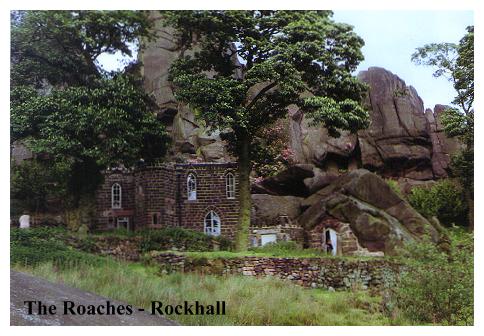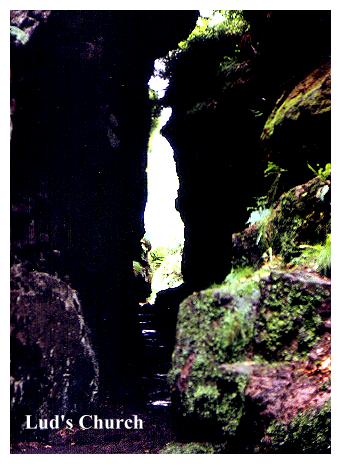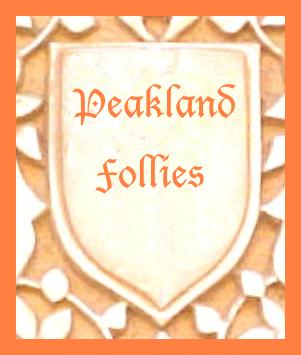10. ROCKHALL, LUDS CHURCH & THE ROACHES
A cave dwellers folly, Soaring crags, sweeping views to the Welsh Marches, an eerie gorge, and if you are lucky - wallabies!
Getting There: Follow the A53 Buxton-Leek Road. Beyond Ramshaw Rocks the road descends steeply to Upper Hulme, passing Hen Cloud and the Roaches on the right. Turn off right to Upper Hulme, crossing stream above works and bearing left then right to the hamlet of Upper Hulme. Continue onwards along the fell road with the high crags of Hen Cloud and the Roaches towering on the right. Park (if possible) at the side of the road.
Distance:Four miles. Not too far, but the rocky moonscape can be hard on the feet!
Map ref: SK 005 622
Rating: Walk *** Follies and General Interest **
Although the walk starts at the roadside near Rockhall Cottage, parking is frequently a problem hereabouts, and on busy weekends a park and ride service runs from the nearby A53 main road. (The A53, incidentally follows the line of the old Roman Road from AQUAE ARNEMETIAE (modern Buxton).

Rockhall Cottage is a 19th century mock gothic villa with a neolithic cave kitchen attached, the whole edifice being built into the base of the Roaches cliff. Today it is the Don Whillans Memorial Hut, a simple hostel for climbers and would be troglodytes, which was opened by Audrey Whillans in January 1993, after a #100,000 refurbishment. The money was provided by climbers, the Sports Council, the Rural Development Commission and the Peak District National Park. Don Whillans was a Salford plumber who died in 1985 at the age of 52. His many acheivements included surviving above 23,00 feet for five days without any food, the first ascent of Annapurna's south face and decking anybody he didn't like - especially coppers intent on removing him from licensed premises! Ironically, the present custodian of the hostel is the local bobby!
The cottage was built in 1850 as a gamekeepers lodge for the Swythamley Estate owned by the Brocklehurst family. The last people to live in the cottage before it became a hostel were Doug Moller and his wife Anne, who left in 1989, having 'endured' the cottage (which has neither water nor electricity) for some twelve years. Doug, 'The King and Lord of the Roaches' wrote a book about his life entitled 'The Wars of the Roaches'. It is said that prior to 1850 there were caves on the site (although considering the gritstone nature of the rock they can hardly have been extensive). One of these, the so called 'Rock Cave' was apparently occupied by one Bess Bowyer, who had been born there in the 18th century and according to legend dwelt there for nigh on a century! It is said her cave home was a haven for deserters, smugglers and all the social undesirables of the area, who were often wont to practice extortion on unsuspecting travellers in the area. She had a daughter too, whose singing could often be heard echoing among the seemingly endless crags on summer nights. One night desperate men came and snatched her away. Not long afterwards poor old Bess was found stone cold in her rocky home.
Rock Hall Cottage has had many famous visitors, but only on one occasion did it play host to royalty. This was on the 23rd August 1872, when Prince Francis the Duke of Teck and his wife Princess Mary Adelaide, came through Leek to picnic with Mr. Brocklehurst of Swythamley Hall. They had been staying with the Earl of Shrewsbury at Alton Towers (see appendix). The visit was not a journey undertaken in quiet anonymity. The royal party as it passed through Leek was led by a brass band, the Leek Rifles, red coated outriders and royal equerries. A crowd of some 9000 people cheered them on. At Rockhall they were received by the Brocklehursts, whereupon they ascended the winding flight of rock-cut stone stairs to the upper crest of the Roaches. On the summit sumptuous tents awaited them, and a special seat for the Princess hewn out of the solid rock. Cushions were placed on the royal 'rock chair', and the whole thing was decked out in white embroidered satin. Beside it flew the Royal Standard. Lunch was served, a tree was planted by the princess, and a 'reet good do' was had by all! The 'Princess's Chair' remains to this day - if you can find it!
Our walk starts at the roadside below Rockhall Cottage. From the gate follow the right hand track a short distance then take path to the left up to the wallside below Rockhall Cottage. Pass through the gate to the left of Rockhall, and ascend to the base of the cliff, where stone steps ascend through the crags. On joining the path at the top turn left, following a route along a rocky terrace with crags above and below. On reaching a notice turn right, ascending yet more steps to the top of the upper set of crags. Turn left, avoiding erosion control barriers, and follow the well defined path along the crest of the Roaches to Doxey Pool. Doxey Pool is curious. It stands hundreds of feet above any known spring in the district, yet is said never to run dry! Beyond Doxey Pool the route winds without complication up to the trig point on the summit. From the summit bear slighly left, descending past boulders to join the tarmac lane at Upper Roach End.
The Roaches are so fantastic as to almost defy description. This dramatic crest of jagged rocks is almost three miles in length and two in breadth. The name is derived from the French 'Roches' and the dramatic footpath along the ridge dates from around 1860. My first encounter with this wondrous explosion of geology was at the tender age of sixteen, when heading northwards with our drama teacher, Janet Beard, after a week at Stratford Upon Avon spent watching Shakespeares Histories, and rehearsing our own forthcoming school 'Macbeth', we stopped here to picnic, and indulge our imaginations in its riot of brooding crags. Ramshaw Rocks became high Dunsinane hill, and a youthful John Duttine and Jim 'Macduff' Jarratt slugged it out among the heather and boulders. For years afterwards I was never able to remember where we had stopped, and it was only relatively recently, that I rediscovered this fantastic place.
The Peak District is a limestone heartland guarded by stern buttresses of Gritstone to the north, the east and the west, but nowhere, except perhaps the eastern 'wall' of crags around Hathersage, is remotely comparable to this jagged razorback of rock, which, were it not for the surrounding moorlands and considerably lower altitude, might lead one to think that one was traversing the Snowdon Horshoe or the Cuillins of Skye!! The Roaches are, of course, a playground for rock climbers and scramblers alike, and though not 'Snowdonian' in height nevertheless offer some fine sweeping views from their lofty, serrated battlements, particularly to the south and west, where views range to the Wrekin in Shropshire and the mountains of Wales. The Roaches offer, despite their humble location on the periphery of the Peak District, one of the finest natural wonders of England. Once visited, it is a place that will draw the visitor again and again.
At Upper Roach End, Cross the lane to the stile opposite, then pass through a second stile to follow a newly surfaced pathway along the ridge, alongside a wall. On reaching a small depression, turn right, following a signed concessionary footpath which leads down the moorside to woodland. (Note campsite opposite). On entering the woods a path is joined. Turn left, following the sign to Lud's Church. After a short woodland walk the path descends slippery mossy steps into Lud's Church.

Here is a place of mysteries! Lud's Church is, in fact, a crevasse some 60 ft high and 200 feet long which has been created by a landslip. At the bottom it is less than seven feet wide, and overhung with dank vegetation which makes it a dark, creepy place. Access to it is down a flight of mossy, slippery steps. It is sometimes known as 'Trafford's Leap' after a local squire who is supposed to have leapt his horse across it while hunting. This 'Green Chapel' has been (predictably!) labelled a hiding place of the bold outlaw Robin Hood, a haunt of elves and fairies, and even an abode of the devil! The best known (and most likely) story however, concerns its use as a place of secret worship by Lollards.
The Lollards were effectively England's first Protestants. They were followers of John Wycliff, a contemporary of Chaucer, who, whilst lecturing in religion and philosphy at Oxford was inspired to embark upon a radical and potentially dangerous quest - the translating of Jerome's Latin Vulgate Bible into English. Wycliff believed that God's word as written directly in the Bible should govern men's lives, rather than that revealed and interpreted by the Church authorities. Needless to say, in the fourteenth century such ideas were heresy. Wycliffe, 'The Morning Star' of the Reformation, died in 1384, before the church had been able to take action against him, but this did not prevent his teachings and writings being banned, and his bones being exhumed and burned in 1428.
Not surprisingly, such a fate was likely to be reserved for Wycliff's followers - if they had the misfortune to be caught. Consequently, their services were usually conducted in secret. The legend of Lud's Church concerns one Walter De Lud-auk, who was the seventy years old pastor of a group of Lollards wont to worship secretly at this lonely spot. Their prescence in the area was known, but the authorities had never been able to discover their meeting place. Furthermore they were under the protection of Henrich Montair, the Head Forester, who would warn them of any danger in the area. Now Walter De Lud-auk had an eighteen year old granddaughter called Alice, who frequently accompanied him at these secret gatherings, and on this particular occasion, while Montair stood guard at the entrance to the chasm, Walter led a short prayer, followed by a hymn and a solo sung by the sweet voiced Girl. Unfortunately her singing was heard by soldiers searching the woods, and before Montair was able to warn the congregation of the danger, the soldiers were at the entrance to the 'church'. Montair the Forester drew his sword and fell upon them, shouting to the Lollards to escape from the other entrance, while he held them at bay. A shot whizzed past him into the chasm as he fought, followed by a loud shriek. He turned to find that poor Alice had been struck in the chest. In a frenzy of anger he killed two of the soldiers and forced the others back, but already the Lollards had begun to emerge from the green chapel, led by Walter carrying the limp body of the girl. They stopped a few yards from the entrance, and then, as the soldiers watched from a safe distance, they dug a grave for the dead girl, and said prayers over it. Afterwards they gave themselves up to the authorities.
Montair, it is said, escaped from captivity and fled to France, on the insistence of the Lollards who knew he was likely to be executed for defending them. As to the Walter and his followers it seems they were imprisoned for their faith though not, it is believed, put to death.
At one time a wooden statue of 'Lady Lud' stood at the northern end of the chasm, in memory, it is said, of poor Alice De Lud-auk. It was in fact a ship's figure head from the good ship Swythamley!! It is often depicted on old postcards of the place.
So there we have it, the legend of Lud's Church. Whether there is any truth in the story or no is debateable. Other explanations also present themselves. 'General Ludd', as is well known, was the leader of the early 19th century Luddites who smashed machines. The name of their mythical leader it is believed, was derived from Robin Hood, and it can be inferred that 'Lud' is in fact the 'Green Man' of Anglo-Saxon pagan belief. Such an eerie 'green chapel' as this might well have been perceived as the refuge of a 'Green Man', a Horned God' (Herne the Hunter'), or a 'Green Knight'. Perhaps Lud's Church is really nothing more than a natural curiosity that incites romantic speculation. But then again......... ??!
At the far exit from Luds Church, turn right, following a long and sometimes muddy path through the woods, contouring the slope with a stream on the left. At a sign and junction of paths descend right to a brooklet then ascend steeply up a stepped path which leads back up the moorside to rejoin the outward route at Upper Roach End. Here you can pass through the gate and follow the fell road back to Rockhall. But most walkers, despite the steep ascent, will wish to retrace their steps back along the summit of the Roaches, which is so good that it warrants 'second helpings'! Perhaps now is the time to keep your eyes skinned for wallabies on the way back! I personally did not see any on my visit, but I am assured that there is a colony of them in the vicinity, whose ancestors escaped from a private zoo at Roach House many years ago. The zoo apparently belonged to one Colonel Brocklehurst, a former Sudan game warden, who had, beside the wallabies, deer, yaks and a kangaroo! Hopefully he had no lions!
There is still one curiosity left to see hereabouts. When you get back to your car drive towards Buxton on the A53 to see the 'Winking Man'! As you ascend the hill keep an eye out on the escarpment on the left. Before long the rough outline of a man's head appears, with an empty gap as an eye socket. As you pass by, rocks behind obscure the gap for a moment and he will wink at you!!








